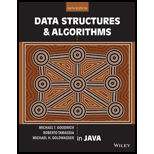
Concept explainers
Explanation of Solution
Implementation of norm(v):
The norm() method takes the input parameter of “vec” to return the Euclidean norm of “vec” array of coordinates.
//Function definition
public static double norm(double[ ] vec)
{
/*Call the norm() by passing the “vec” and “2” and return the result of computed value. */
return norm(vec,2);
}
Explanation:
In norm() method,
- It takes the input parameter of “vec”.
- Call the norm() method by passing the “vec” and “2” and return the result of computed value of p-norm value of “vec” array of coordinates.
Implementation of norm(v, p):
The norm() method takes the input parameter of “vec” and “pow” to return the p-norm value of “vec” array of coordinates.
//Function definition
public static double norm(double[ ] vec, int pow)
{
//Declare the variables
int sum = 0;
double exp = 1.0/pow;
//Loop executes until from “i” to "vec"
for (double i : vec)
//Add the "sum" and the power of number
sum += Math.pow(i,pow);
//Return the return
return Math.pow(sum, exp);
}
Explanation:
In norm() method,
- It takes the input parameter of “vec” and “pow”.
- Loop executes until the “vec” to add the sum and power of input.
- Return the computed p-norm value of “vec” array of coordinates.
Complete Program:
/**********************************************************
* Program demonstrates how to determine the Euclidean norm*
* for two-dimensional
Want to see the full answer?
Check out a sample textbook solution
Chapter 1 Solutions
Data Structures and Algorithms in Java
- Please solve and answer the questions correctly please. Thank you!!arrow_forwardConsidering the TM example of binary sum ( see attached)do the step-by-step of execution for the binary numbers 1101 and 11. Feel free to use the Formal Language Editor Tool to execute it; Write it down the current state of the tape (including the head position) and indicate the current state of the TM at each step.arrow_forwardI need help on inculding additonal code where I can can do the opposite code of MatLab, where the function of t that I enter becomes the result of F(t), in other words, turning the time-domain f(t) into the frequency-domain function F(s):arrow_forward
 C++ for Engineers and ScientistsComputer ScienceISBN:9781133187844Author:Bronson, Gary J.Publisher:Course Technology Ptr
C++ for Engineers and ScientistsComputer ScienceISBN:9781133187844Author:Bronson, Gary J.Publisher:Course Technology Ptr Operations Research : Applications and AlgorithmsComputer ScienceISBN:9780534380588Author:Wayne L. WinstonPublisher:Brooks Cole
Operations Research : Applications and AlgorithmsComputer ScienceISBN:9780534380588Author:Wayne L. WinstonPublisher:Brooks Cole C++ Programming: From Problem Analysis to Program...Computer ScienceISBN:9781337102087Author:D. S. MalikPublisher:Cengage Learning
C++ Programming: From Problem Analysis to Program...Computer ScienceISBN:9781337102087Author:D. S. MalikPublisher:Cengage Learning EBK JAVA PROGRAMMINGComputer ScienceISBN:9781337671385Author:FARRELLPublisher:CENGAGE LEARNING - CONSIGNMENTProgramming Logic & Design ComprehensiveComputer ScienceISBN:9781337669405Author:FARRELLPublisher:Cengage
EBK JAVA PROGRAMMINGComputer ScienceISBN:9781337671385Author:FARRELLPublisher:CENGAGE LEARNING - CONSIGNMENTProgramming Logic & Design ComprehensiveComputer ScienceISBN:9781337669405Author:FARRELLPublisher:Cengage Systems ArchitectureComputer ScienceISBN:9781305080195Author:Stephen D. BurdPublisher:Cengage Learning
Systems ArchitectureComputer ScienceISBN:9781305080195Author:Stephen D. BurdPublisher:Cengage Learning





